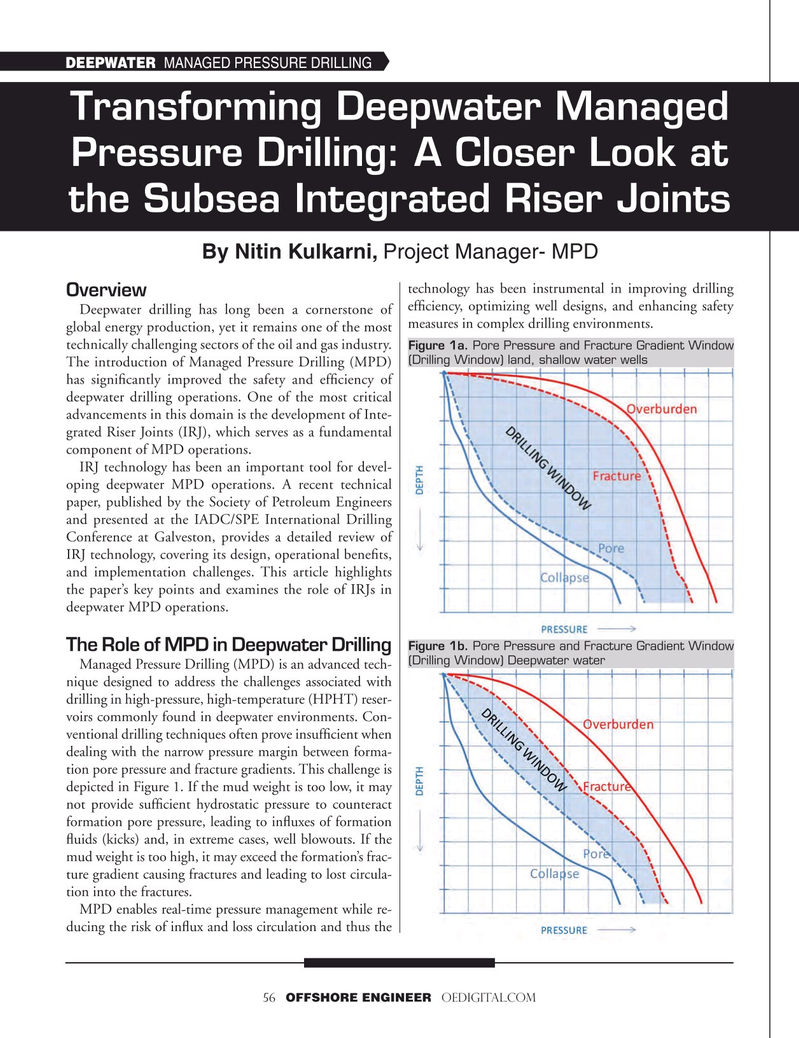
Page 56: of Offshore Engineer Magazine (Mar/Apr 2025)
Read this page in Pdf, Flash or Html5 edition of Mar/Apr 2025 Offshore Engineer Magazine
DEEPWATER MANAGED PRESSURE DRILLING
Transforming Deepwater Managed
Pressure Drilling: A Closer Look at the Subsea Integrated Riser Joints
By Nitin Kulkarni, Project Manager- MPD technology has been instrumental in improving drilling
Overview
Deepwater drilling has long been a cornerstone of effciency, optimizing well designs, and enhancing safety global energy production, yet it remains one of the most measures in complex drilling environments.
technically challenging sectors of the oil and gas industry.
Figure 1a. Pore Pressure and Fracture Gradient Window (Drilling Window) land, shallow water wells
The introduction of Managed Pressure Drilling (MPD) has signifcantly improved the safety and effciency of deepwater drilling operations. One of the most critical advancements in this domain is the development of Inte- grated Riser Joints (IRJ), which serves as a fundamental component of MPD operations.
IRJ technology has been an important tool for devel- oping deepwater MPD operations. A recent technical paper, published by the Society of Petroleum Engineers and presented at the IADC/SPE International Drilling
Conference at Galveston, provides a detailed review of
IRJ technology, covering its design, operational benefts, and implementation challenges. This article highlights the paper’s key points and examines the role of IRJs in deepwater MPD operations.
Figure 1b. Pore Pressure and Fracture Gradient Window
The Role of MPD in Deepwater Drilling (Drilling Window) Deepwater water
Managed Pressure Drilling (MPD) is an advanced tech- nique designed to address the challenges associated with drilling in high-pressure, high-temperature (HPHT) reser- voirs commonly found in deepwater environments. Con- ventional drilling techniques often prove insuffcient when dealing with the narrow pressure margin between forma- tion pore pressure and fracture gradients. This challenge is depicted in Figure 1. If the mud weight is too low, it may not provide suffcient hydrostatic pressure to counteract formation pore pressure, leading to infuxes of formation fuids (kicks) and, in extreme cases, well blowouts. If the mud weight is too high, it may exceed the formation’s frac- ture gradient causing fractures and leading to lost circula- tion into the fractures.
MPD enables real-time pressure management while re- ducing the risk of infux and loss circulation and thus the 56 OFFSHORE ENGINEER OEDIGITAL.COM

 55
55

 57
57